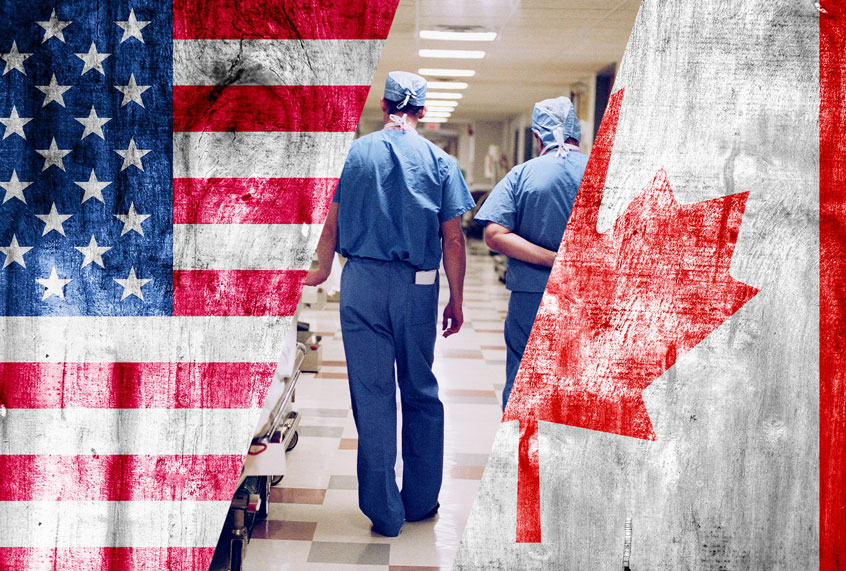The cost of administering health care in the United States costs four times as much as it does in Canada, which has had a single-payer system for nearly 60 years, according to a new study.
The average American pays a whopping $2,497 per year in administrative costs — which fund insurer overhead and salaries of administrative workers as well as executive pay packages and growing profits — compared to $551 per person per year in Canada, according to a study published in the Annals of Internal Medicine last month. The study estimated that cutting administrative costs to Canadian levels could save more than $600 billion per year.
The data contradicts claims by opponents of single-payer health care systems, who have argued that private programs are more efficient than government-run health care. The debate over the feasibility of a single-payer health care has dominated the Democratic presidential race, where candidates like Sen. Bernie Sanders, I-Vt., and Sen. Elizabeth Warren, D-Mass., advocate for a system similar to Canada’s while moderates like former Vice President Joe Biden and former South Bend, Indiana Mayor Pete Buttigieg have warned against scrapping private health care plans entirely.
Canada had administrative costs similar to those in the United States before it switched to a single-payer system in 1962, according to the study’s authors, who are researchers at Harvard Medical School, the City University of New York at Hunter College, and the University of Ottawa. But by 1999, administrative costs accounted for 31% of American health care expenses, compared to less than 17% in Canada.
The costs have continued to increase since 1999. The study found that American insurers and care providers spent a total of $812 billion on administrative costs in 2017, more than 34% of all health care costs that year. The largest contributor to the massive price tag was insurance overhead costs, which totaled more than $275 billion in 2017.
“The U.S.-Canada disparity in administration is clearly large and growing,” the study’s authors wrote. “Discussions of health reform in the United States should consider whether $812 billion devoted annually to health administration is money well spent.”
The increase in costs was driven in large part due to private insurers’ growing role in administering publicly-funded Medicare and Medicaid programs. More than 50% of private insurers’ revenue comes from Medicare and Medicaid recipients, according to the study. Roughly 12% of premiums for private Medicare Advantage plans are spent on overhead, compared to just 2% in traditional Medicare programs. Medicaid programs also showed a wide disparity in costs in states that shifted many of their Medicaid recipients into private managed care, where administrative costs are twice as high. There was little increase in states that have full control over their Medicaid programs.
As a result, Americans pay far more for the same care.
The average American spent $933 in hospital administration costs, compared to $196 in Canada, according to the research. Americans paid an average of $844 on insurance companies’ overhead, compared to $146 in Canada. Americans spent an average of $465 for physicians’ insurance-related costs, compared to $87 in Canada.
“The gap in health administrative spending between the United States and Canada is large and widening, and it apparently reflects the inefficiencies of the U.S. private insurance-based, multipayer system,” the authors wrote. “The prices that U.S. medical providers charge incorporate a hidden surcharge to cover their costly administrative burden.”
Despite the massive difference in administrative costs, a 2007 study by the Centers for Disease Control and Canada’s health authority found that the overall health of residents in both countries is very similar, though the US actually trails in life expectancy, infant mortality, and fitness.
Many of the additional administrative costs in the US go toward compensation packages for insurance executives, some of whom pocket more than $20 million per year, and billions in profits collected by insurers.
“Americans spend twice as much per person as Canadians on health care. But instead of buying better care, that extra spending buys us sky-high profits and useless paperwork,” said Dr. David Himmelstein, the study’s lead author and a distinguished professor at Hunter College. “Before their single-payer reform, Canadians died younger than Americans, and their infant mortality rate was higher than ours. Now Canadians live three years longer and their infant mortality rate is 22% lower than ours. Under Medicare for All, Americans could cut out the red tape and afford a Rolls Royce version of Canada’s system.”
Himmelstein later told Time that the difference in administrative costs between the two countries would “not only cover all the uninsured but also eliminate all the copayments and deductibles.”
“And, frankly, have money left over,” he added.
Democrats like Biden and Buttigieg have argued that it would be a mistake to switch to a single-payer system because many people have private insurance plans they like. Both have proposed a public option, which would allow people to buy into a government-run health care program but would not do away with private plans.
But study senior author Dr. Steffie Woolhandler, at Hunter College and lecturer at Harvard Medical School, argued that a public option would make things worse, not better, because they would leave profit-seeking private insurance in place.
“Medicare for All could save more than $600 billion each year on bureaucracy, and repurpose that money to cover America’s 30 million uninsured and eliminate copayments and deductibles for everyone,” she said. “Reforms like a public option that leave private insurers in place can’t deliver big administrative savings. As a result, public option reform would cost much more and cover much less than Medicare for All.”

